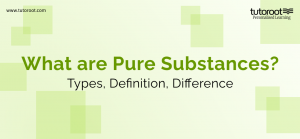What are Pure Substances? Types, Definition, Difference

Everything on Earth is a kind of matter, which is defined as any material that occupies space and has mass. The matter is further subdivided into solid, liquid, and gas forms. Aside from this, it is also divided into pure substances and mixtures.
Types of substances
Substances are divided into two categories. They are:
- Pure Substance: Pure substances are just one type of particle.
- Mixtures: Mixtures are substances that contain two or more distinct particles.
What is a Pure Substance?
Pure substances are made up of only one type of particle with a definite or consistent structure. These chemicals are further subdivided into elements and compounds.
Elements are compounds that cannot be broken down further. Even employing physical or chemical techniques, an element cannot be converted into a new element. They mostly contain metals, nonmetals, or metalloids.
Compounds, on the other hand, are pure substances generated when two or more different elements are chemically mixed with a predetermined ratio of their atoms. However, chemical procedures can be used to separate complicated compounds into their constituent parts.
Types of Pure Substances
Pure substances are classified into two categories:
- Elements: An element is a pure material with only one kind of atom that cannot be broken down into two or simpler compounds by physical or chemical processes.
- Compounds: A compound is a pure material that is made up of two or more components that have been chemically mixed in a certain proportion.
Examples of Pure Substances
The following are some instances of pure substances:
Steel, Iron, Gold, Diamond, Water, Copper, and other metals. Also, the air is frequently regarded as a pure material. Some compounds, such as salt, crystals, or baking soda, are considered pure substances.
Properties and Characteristics of Pure Substance
- Pure substances are generally homogenous, possessing only one type of atom or molecule.
- These compounds are primarily composed of a continuous or homogeneous composition throughout.
- Fixed boiling and melting points of the chemicals.
- The pure material is frequently involved in a chemical process that has predictable results.
What are Mixtures?
A mixture is a material made up of two or more separate components that have been physically mixed. A combination may typically be split back into its constituents. Impure substances are sometimes known as mixes.
Types of mixtures
Mixtures are further divided into two types.
- A homogeneous mixture, often known as a solution, has a relatively continuous configuration. Every unit in the combination is identical to every other unit. For example, if you liquefy sugar in water and thoroughly mix it, your concoction will taste virtually the same no matter where you sample it. Two or more chemical compounds are present in this combination.
- A heterogeneous mixture is a concoction whose structure changes from place to place within the sample. For example, Sugar and sand combine to make a complex combination. Looking closely, you may see tiny sugar crystals and sand particles. These combinations may be detected visually and physically separated.
Examples of a Mixture
In the atmosphere, gases mix, such as nitrogen and oxygen.
- A mixture of water and oil.
- Water and other liquids.
- Sand and water, etc.
Properties and Characteristics of Impure Substances or Mixtures
- It has no distinct qualities; rather, the properties of the mixture are a product of the average attributes of all of its elements.
- It is the outcome of a bodily alteration.
- They differ in composition.
- Their melting and boiling points are not the same.
The Differences Between Pure Substances and Mixtures
Here are characteristics that distinguish pure substances from mixtures:
| Pure substances | Mixtures |
| Components cannot be divided or broken into new products. | Components can be divided |
| Constant Properties | Varying properties |
| Made of a single-element | Combination of two or more elements |
Final Notes
The above article provided a comprehensive description of what substance is, what is a pure substance, its types, and its characteristics while also sharing brief details about what are mixtures, their types, and characteristics. Moreover, if you are interested in learning more chemistry topics, join Tutoroot’s one on one personalised online tuition classes. A place where you enjoy the journey of learning while also improving your grades.
For simplified explanations like the one above, visit the chemistry blogs on the Tutoroot website. Elevate your learning with Tutoroot’s personalised Chemistry online tuition. Begin your journey with a FREE DEMO session and discover the advantages of one-on-one online guidance.
FAQ’s
What is Substance?
A substance is defined as “a matter with a specific composition and properties.”
Is ice a pure substance?
Yes, ice is a pure substance as it is a solid form of water.
Examples of Impure Substances?
- Salt mixed in water
- Petrol
- Sea water
- Steel
- Carbonated water
- Chocolate cookie
